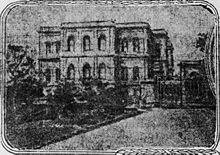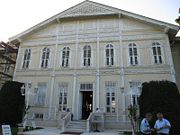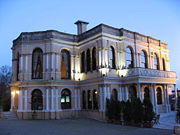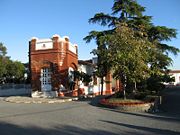
Yildiz Palace
Encyclopedia

Ottoman Empire
The Ottoman EmpireIt was usually referred to as the "Ottoman Empire", the "Turkish Empire", the "Ottoman Caliphate" or more commonly "Turkey" by its contemporaries...
pavilions and villas in Istanbul
Istanbul
Istanbul , historically known as Byzantium and Constantinople , is the largest city of Turkey. Istanbul metropolitan province had 13.26 million people living in it as of December, 2010, which is 18% of Turkey's population and the 3rd largest metropolitan area in Europe after London and...
, Turkey
Turkey
Turkey , known officially as the Republic of Turkey , is a Eurasian country located in Western Asia and in East Thrace in Southeastern Europe...
, built in the 19th and early 20th centuries. It was used as a residence by the Sultan and his court in the late 19th century.
Origin
Yıldız Palace, meaning "Star Palace", was built in 1880 and was used by the OttomanOttoman Empire
The Ottoman EmpireIt was usually referred to as the "Ottoman Empire", the "Turkish Empire", the "Ottoman Caliphate" or more commonly "Turkey" by its contemporaries...
Sultan Abdülhamid II. The area of the palace was originally made of natural woodlands and became an imperial estate during the reign of Sultan Ahmed I
Ahmed I
Ahmed I or Ahmed Bakhti was the Sultan of the Ottoman Empire from 1603 until his death in 1617.-Biography:...
(1603-1617). Various sultans after Ahmed I enjoyed vacationing on these lands and Sultans Abdülmecid I
Abdülmecid I
Sultan Abdülmecid I, Abdul Mejid I, Abd-ul-Mejid I or Abd Al-Majid I Ghazi was the 31st Sultan of the Ottoman Empire and succeeded his father Mahmud II on July 2, 1839. His reign was notable for the rise of nationalist movements within the empire's territories...
and Abdülaziz
Abdülâziz
Abdülaziz I or Abd Al-Aziz, His Imperial Majesty was the 32nd Sultan of the Ottoman Empire and reigned between 25 June 1861 and 30 May 1876...
built mansions here.
In the late 19th century, Sultan Abdülhamid II left Dolmabahçe
Dolmabahçe Palace
Dolmabahçe Palace located in the Beşiktaş district of Istanbul, Turkey, on the European coastline of the Bosphorus strait, served as the main administrative center of the Ottoman Empire from 1856 to 1922, apart from a 22-year interval in which Yıldız Palace was used.- History :Dolmabahçe Palace...
because he feared a seaside attack on the palace, which is located at the shore of the Bosporus
Bosporus
The Bosphorus or Bosporus , also known as the Istanbul Strait , is a strait that forms part of the boundary between Europe and Asia. It is one of the Turkish Straits, along with the Dardanelles...
strait. He expanded the Yıldız Palace and ordered the renowned Italian architect Raimondo D'Aronco to build new buildings to the palace complex. When he moved there, the palace became the fourth seat of Ottoman government (the previous ones were the Eski Saray (Old Palace) in Edirne
Edirne
Edirne is a city in Eastern Thrace, the northwestern part of Turkey, close to the borders with Greece and Bulgaria. Edirne served as the capital city of the Ottoman Empire from 1365 to 1453, before Constantinople became the empire's new capital. At present, Edirne is the capital of the Edirne...
, and the Topkapı
Topkapi Palace
The Topkapı Palace is a large palace in Istanbul, Turkey, that was the primary residence of the Ottoman Sultans for approximately 400 years of their 624-year reign....
and Dolmabahçe
Dolmabahçe Palace
Dolmabahçe Palace located in the Beşiktaş district of Istanbul, Turkey, on the European coastline of the Bosphorus strait, served as the main administrative center of the Ottoman Empire from 1856 to 1922, apart from a 22-year interval in which Yıldız Palace was used.- History :Dolmabahçe Palace...
Palaces in Istanbul.)
Layout
The palace is a complex of buildings including the State Apartments (Büyük Mabeyn), Şale Pavilion, the Malta Pavilion, the Çadır Pavilion, the Yıldız Theater and Opera House, the Yıldız Palace Museum, and the Imperial Porcelain Factory. The Yıldız Palace Gardens are also a popular public site among the residents of Istanbul. A bridge connects the Yıldız Palace with the Çırağan PalaceÇiragan Palace
Çırağan Palace , a former Ottoman palace, is now a five-star hotel of the Kempinski Hotels chain. It is located on the European shore of the Bosporus between Beşiktaş and Ortaköy in Istanbul, Turkey.- History :...
on the Bosporus through this garden.
State apartments
Government officials working for Abdülhamid II had their offices in this building.Şale Kiosk

Chalet
A chalet , also called Swiss chalet, is a type of building or house, native to the Alpine region, made of wood, with a heavy, gently sloping roof with wide, well-supported eaves set at right angles to the front of the house.-Definition and origin:...
, hence the name Şale. Winston Churchill
Winston Churchill
Sir Winston Leonard Spencer-Churchill, was a predominantly Conservative British politician and statesman known for his leadership of the United Kingdom during the Second World War. He is widely regarded as one of the greatest wartime leaders of the century and served as Prime Minister twice...
and Charles de Gaulle
Charles de Gaulle
Charles André Joseph Marie de Gaulle was a French general and statesman who led the Free French Forces during World War II. He later founded the French Fifth Republic in 1958 and served as its first President from 1959 to 1969....
were among the visitors to this part of the palace. The second section was added in 1889 to accommodate Kaiser Wilhelm II, who was the first foreign monarch to visit Constantinople. It was during this phase that the Sedefli Salon (Mother-of-Pearl Salon) was added. The name derives from the extensive use of mother-of-pearl that covered almost all of its surfaces. There are also detailed painted landscapes on the ceiling. The third section was also built for Kaiser Wilhelm II in 1898. The reception chamber was built during this period and remains the most impressive room in the entire Şale Pavilion. There is a single carpet on the floor that has an area greater than 400 square meters and was hand woven by 60 weavers. Elegant features of the chamber include a gilded, coffered ceiling and large mirrors. Abdülhamid II was a skilled carpenter and actually made some of the pieces of furniture that can be found in the Şale Pavilion.
Malta Kiosk

Pavilion (structure)
In architecture a pavilion has two main meanings.-Free-standing structure:Pavilion may refer to a free-standing structure sited a short distance from a main residence, whose architecture makes it an object of pleasure. Large or small, there is usually a connection with relaxation and pleasure in...
located in Yıldız Park to the north side of the wall separating Yıldız Palace. There are also two watching and resting pavilions in the grove being the rear garden of Çırağan Palace from the Abdül Aziz I period. The origin of the name is not certain: that during the Ottoman era certain parts of palaces were called after the names of conquered places or important battles, so this name is given after the siege
Siege of Malta (1565)
The Siege of Malta took place in 1565 when the Ottoman Empire invaded the island, then held by the Knights Hospitaller .The Knights, together with between 4-5,000 Maltese men,...
of Malta.
The trial of Midhat Pasha took place in a tent behind the pavilion.
Çadır Kiosk

Abdülâziz
Abdülaziz I or Abd Al-Aziz, His Imperial Majesty was the 32nd Sultan of the Ottoman Empire and reigned between 25 June 1861 and 30 May 1876...
(1861-76), who used them as prisons. Today it houses a café and restaurant.
Yıldız Theater and Opera House
Built by Sultan Abdülhamid II in 1889, it has stars on its domed ceiling, a reference to the name of the Yıldız Palace, which means Star Palace. Because noone was allowed to have his back to the sultan, the positioning of the sultan’s balcony box meant that the first row seats were never used.Yıldız Palace Museum
This used to be Abdülhamid II’s carpentry workshop and is now used to display art and objects from the palace.Imperial Porcelain Factory

Present use
After the Ottoman Empire ended, the palace was used as a luxury casino before being converted into a guest house for visiting heads of state and royalty. Today it is a museum and its gardens can be used for private receptions, such as the Istanbul Antiques Fair at the Silahhane (Armoury) Hall, which usually takes place in November. The Istanbul office of the OIC is also located within the Yıldız Palace.The palace is in the Beşiktaş
Besiktas
Beşiktaş is a municipality of Istanbul, Turkey, located on the European shore of the Bosphorus. It is bordered on the north by Sarıyer and Şişli, on the west by Kağıthane and Şişli, on the south by Beyoğlu, and on the east by the Bosphorus...
district of Istanbul and is open daily from 9:30 to 16:00, except on Mondays and Thursdays, from October to February; and between 9:30 to 17:00 from March to September.
Literature
- Önder Küçükerman, Nedret Bayraktar, Semra Karakaţli. Yıldız Porcelain in National Palaces Collection. TBMM, Istanbul, 1998.
- Vahide Gezgör, Feryal Irez. Yıldız Palace Chalet Kasr-ı Hümayunu. TBMM, Istanbul, 1993.

